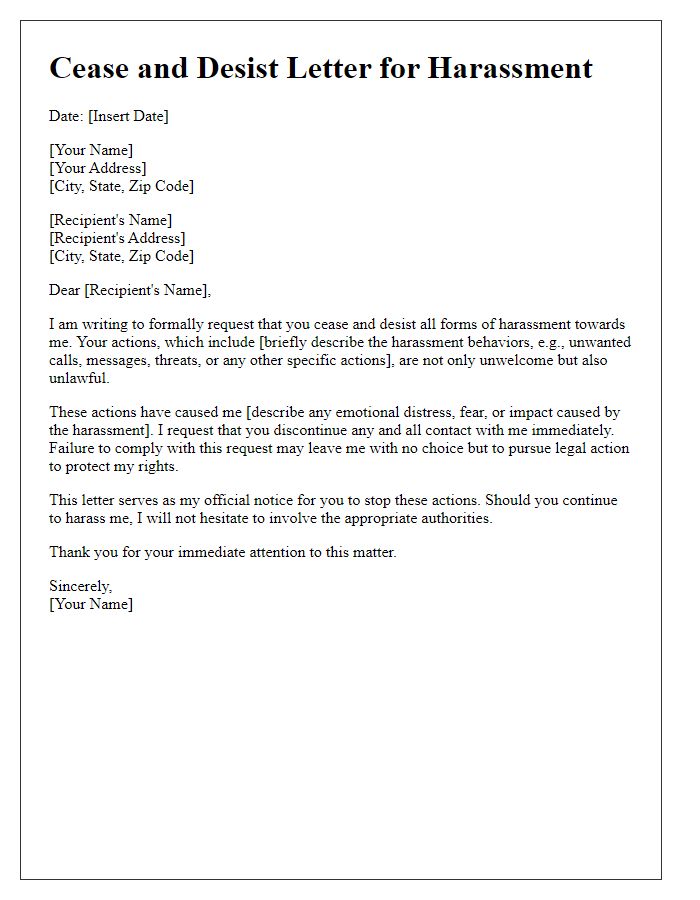Are you looking to put an end to unwanted actions or communications in a clear and professional manner? A cease and desist letter is an effective tool to assert your rights and demand that the offending party stop their behavior immediately. Crafting such a letter can seem daunting, but with a few key components, you can ensure your message is strong and concise. If you're ready to learn how to draft your own cease and desist letter, keep reading for a comprehensive guide!

Clear identification of parties involved
In cease and desist communications, precise identification of parties involved is crucial. The sender, often an individual or legal entity like a business, should provide their full name (including title if applicable), address (street, city, state, zip code), and contact information (phone number, email). The recipient, who could be another individual or entity, must also be clearly identified with similar details, ensuring there's no ambiguity regarding the involved parties. This clarity sets the stage for the formal nature of the correspondence and aids in any legal proceedings that may arise subsequently.
Description of the infringing behavior
Infringement of intellectual property rights often occurs when individuals or companies use protected material without permission. A common example includes unauthorized reproduction of copyrighted works, such as literature, music, or software. For instance, a business may sell counterfeit products that mimic a brand's trademarks, leading to confusion among consumers regarding the source of goods. Such actions not only violate copyright laws but also undermine market integrity and harm the original rights holder's reputation and revenue. Failure to address these infringements can result in legal action and financial penalties, emphasizing the importance of protecting proprietary content and ensuring compliance with intellectual property regulations.
Legal grounds and rights being invoked
Cease and desist letters serve as formal requests to halt activities that infringe on legal rights, such as copyright or trademark violations. The legal grounds typically invoked in these letters include intellectual property laws, contract law, and applicable state or federal regulations that protect rights holders. For example, copyright infringement under Title 17 of the United States Code safeguards original works, while trademark law, defined under the Lanham Act, protects brand identity and prevents confusion in the marketplace. The recipient should be made aware of the potential consequences of non-compliance, including legal actions, financial penalties, and injunctive relief, which could significantly impact their operations. Clear identification of the infringed rights, supporting evidence, and a timeframe for compliance are crucial components to ensure the enforceability of the demands.
Specific demands and deadline for compliance
Cease and desist communications typically demand the cessation of specific activities, often due to legal violations or infringement. In such communications, it is important to clearly outline the particular actions that must be stopped, stating the reasons for the demand, including relevant laws or agreements. Additionally, a compliance deadline should be assigned, allowing sufficient time (commonly 10 to 30 days) for the recipient to respond and adhere to these demands. Documentation should also indicate potential legal actions that may arise if compliance is not met by the specified date. Overall, clarity and precision are crucial to convey the seriousness of the matter and the necessity for immediate action.
Potential legal consequences for non-compliance
A cease and desist communication serves as a formal warning regarding potential legal actions in cases of unlawful behavior. This document typically details specific violations, possibly of intellectual property rights or contractual obligations. Ignoring such a letter can expose the recipient, whether an individual or corporation, to litigation, resulting in costly legal fees and adverse judgments. Courts may impose penalties, including monetary damages that can reach into the thousands or even millions of dollars, depending on the severity and impact of the infringement. Furthermore, continued non-compliance might lead to temporary or permanent injunctions, prohibiting the offending party from engaging in certain activities, especially in prominent jurisdictions like New York or California, where strict enforcement of these matters is common.













Comments